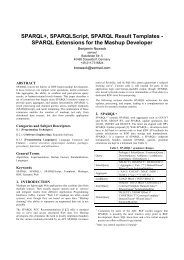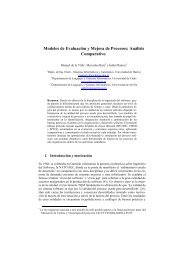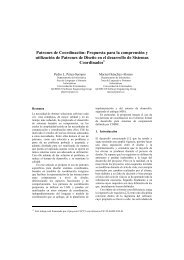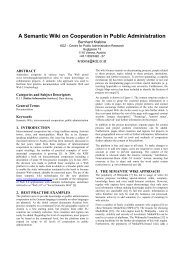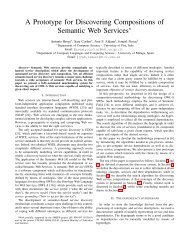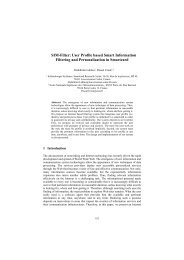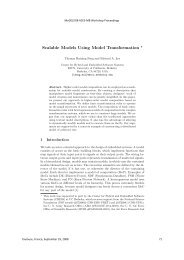ontology-based information extraction systems (obies 2008)
ontology-based information extraction systems (obies 2008)
ontology-based information extraction systems (obies 2008)
Create successful ePaper yourself
Turn your PDF publications into a flip-book with our unique Google optimized e-Paper software.
Information Extraction Based on Extraction Ontologies:<br />
Design, Deployment and Evaluation<br />
Martin Labsk´y, Vojtěch Svátek, and Marek Nekvasil<br />
University of Economics, Prague, Dept. Information and Knowledge Engineering,<br />
Winston Churchill Sq. 4, 130 67 Praha 3, Prague, Czech Republic<br />
labsky@vse.cz, svatek@vse.cz, nekvasim@vse.cz<br />
Abstract. Most IE methods do not provide easy means for integrating complex<br />
prior knowledge that can be provided by human experts. Such knowledge is especially<br />
valuable when there are no or little training data. In the paper we elaborate<br />
on the <strong>extraction</strong> <strong>ontology</strong> paradigm; the distinctive features of our system called<br />
Ex are 1) probabilistic reasoning over extractable attribute and instance candidates<br />
and 2) combination of the <strong>extraction</strong> <strong>ontology</strong> approach with the inductive<br />
and (to some degree) wrapper approach. We also discuss the issues related to the<br />
deployment and evaluation of applications <strong>based</strong> on <strong>extraction</strong> ontologies.<br />
1 Introduction<br />
In the last decade, web <strong>information</strong> <strong>extraction</strong> (WIE) was dominated by two styles.<br />
One—wrapper-<strong>based</strong>—is quite reliable but strictly depends on the formatting regularity<br />
of pages. The other—inductive—paradigm assumes the presence of annotated<br />
training data, which is rarely fulfilled in real-world settings, and manual labelling of<br />
training data is often unfeasible. In addition, both approaches usually deliver extracted<br />
<strong>information</strong> as weakly semantically structured; if WIE is to be used to fuel semantic<br />
web repositories, secondary mapping to ontologies is typically needed, which makes<br />
the process complicated and may introduce additional errors [4].<br />
There were recently proposals for pushing ontologies towards the actual <strong>extraction</strong><br />
process as immediate prior knowledge. Extraction ontologies [3] define the concepts the<br />
instances of which are to be extracted in the sense of various attributes, their allowed<br />
values as well as higher-level Extraction ontologies are assumed to be hand-crafted<br />
<strong>based</strong> on observation of a sample of resources; they allow for rapid start of the actual<br />
<strong>extraction</strong> process, as even a very simple <strong>extraction</strong> <strong>ontology</strong> (designed by a competent<br />
person) is likely to cover a sensible part of target data and generate meaningful<br />
feedback for its own redesign. The clean and rich conceptual structure (allowing partial<br />
intra-domain reuse and providing immediate semantics to extracted data) makes <strong>extraction</strong><br />
ontologies superior to ad-hoc hand-crafted patterns used in early times of WIE.<br />
However, many aspects of their usage still need to be explored.<br />
Section 2 of the paper briefly reviews the features of our WIE tool named Ex (see [5]<br />
for a more thorough description). Section 3 drafts a larger context of the <strong>ontology</strong>-<strong>based</strong><br />
<strong>extraction</strong> task, namely, the design of <strong>extraction</strong> ontologies (incl. their relationship to<br />
usual domain ontologies), practical aspects of their usage, and their evaluation. Finally,<br />
Section 4 summarises the contributions of the paper.



